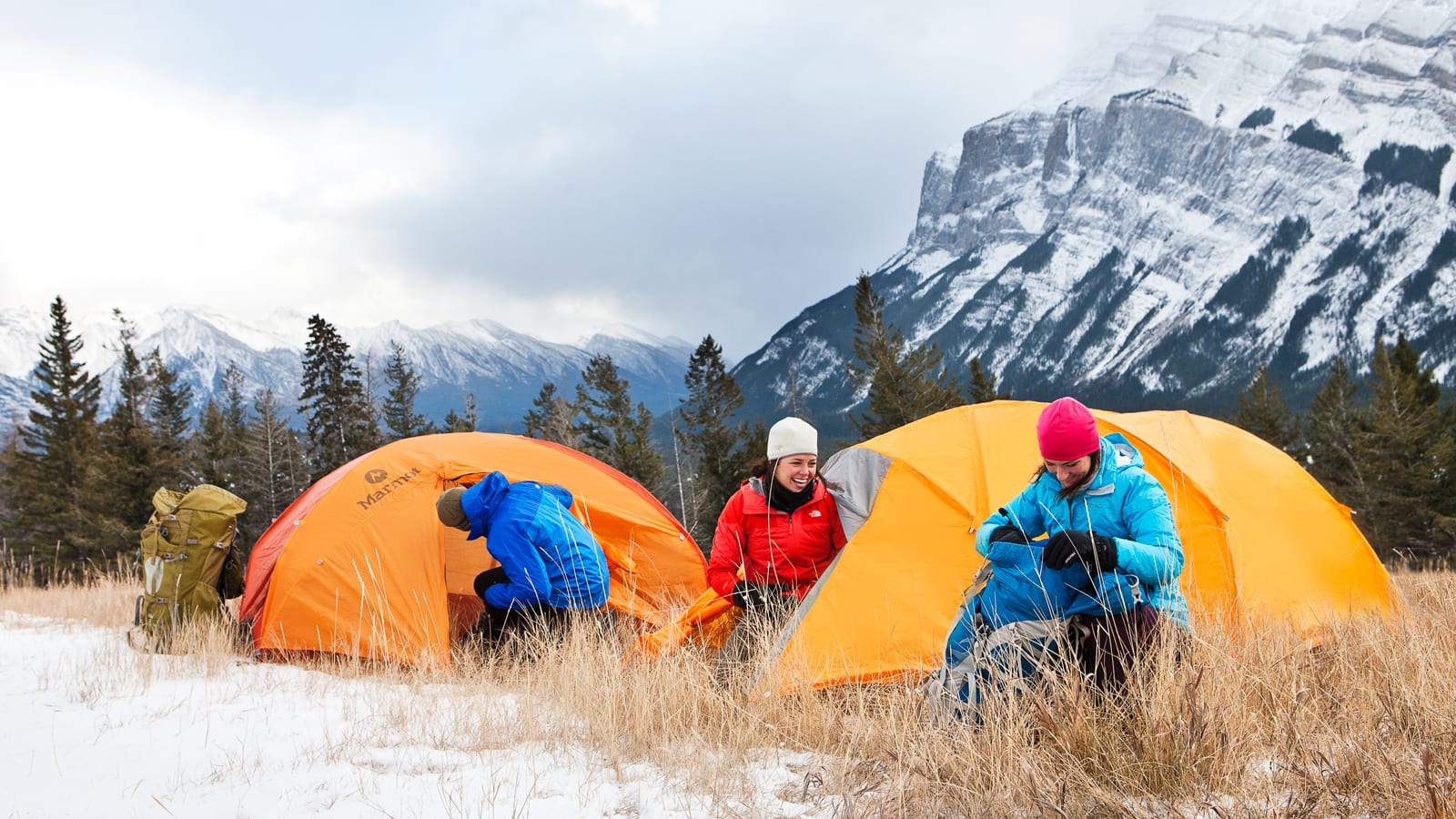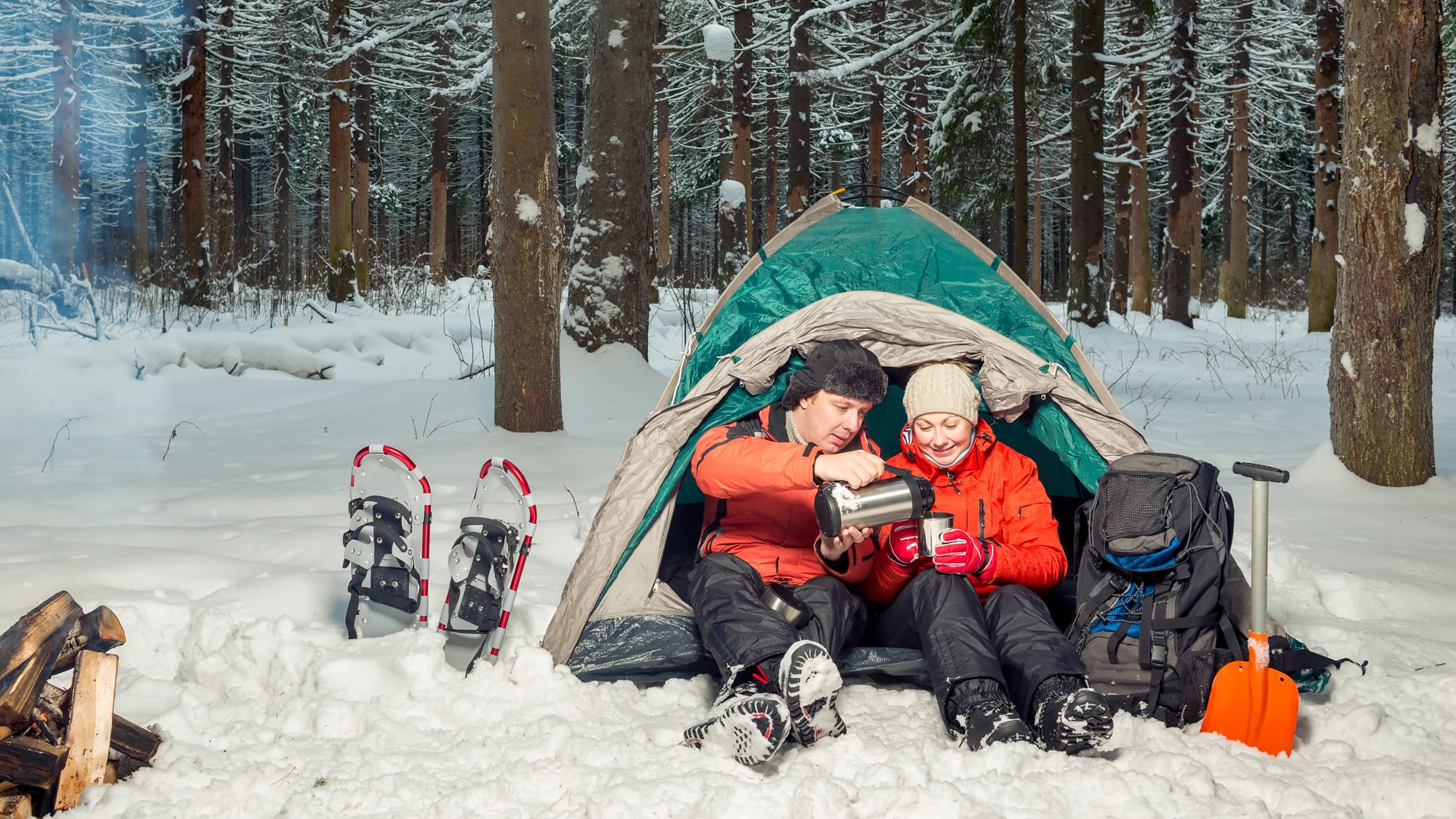An ever-growing number of Albertans are embracing winter camping. As with spring and summer camping, it’s a great way to escape the daily urban grind, bond with family and friends, and recharge amidst the province’s natural splendour. But it’s also not without its challenges. That’s why we asked David Delafield, an assistant professor and co-chair of the Outward Pursuits program at Burman University in Lacombe, for his best Alberta winter camping tips. Whether you’re heading out to Jasper National Park or one of Alberta’s many provincial parks and recreation areas, prepare for your trip with Delafield’s advice—for packing right, choosing a campsite and, above all, staying warm and dry.
UNDERSTANDING TEMPERATURE
Before embarking on a winter camping excursion, you’ll want to have a good sense of the environmental conditions you’ll be facing. In Alberta, the ideal air temperature for winter camping is between -5 and -20 C. That’s cold enough that you’re unlikely to experience heavy snow melt, which can make camping miserable. But it’s also warm enough that, assuming you take appropriate precautions, you should be able to camp in relative comfort.
Below -20 C, simply staying warm becomes a full-time job, which detracts from the enjoyment of being outdoors. Winter temperatures above -5 C can likewise be problematic, particularly if stickier snow soaks into your clothing, causing you to be damp and cold.
CHOOSING A CAMPSITE
“In winter I prefer a campsite that’s set back in the trees for wind protection, but which is also on moderately high ground,” Delafield says. “Cold air is heavy and flows like water, so it’s wise to avoid lower-lying areas, ravines and other hollows in the landscape.”
Of course, snow can also be heavy. If it’s resting in large amounts on tree limbs above your site, beware that it could fall on you or your tent—or it could cause the limbs themselves to fall. Likewise, avalanches are a risk in mountainous terrain, so don’t camp on or near steep slopes, and avoid travel in these areas. (Delafield encourages backcountry winter campers and hikers to take an avalanche skills training course, the better to identify avalanche risks.)
PITCHING YOUR TENT
Assuming your campsite has some snow cover, pack it down with your snowshoes or skis. “In minutes the snow pack will become firmer, and within an hour or so you’ll be able to walk on a newly leveled, smoothed and hardened custom campsite,” Delafield says.
You may also wish to anchor your tent using specialized aluminum snow stakes. Or lacking those, try improvising “deadman” anchors using available logs, branches or rocks: make a small hollow in the snow; fasten tent guylines to the anchor; then place it in the hollow, cover it and stomp it down to freeze it in place.
WHAT TO WEAR, PART ONE
Your clothing—and how you layer it—is a major factor when it comes to your comfort and safety when camping in cold, snowy conditions. It needs to be able to help you both conserve your body heat and release excess heat, depending on your environment and level of activity.
“When you’re active, your body produces heat and moisture that needs to be released, but when you’re just sitting around camp, you need to capture and conserve that heat,” Delafield says. “By layering, you can seamlessly transition from venting excess heat to conserving it.”
He advises that campers think of winter wear as a four-part system.
Base layer: Fit snug against your skin. Ideally a wicking material such as merino wool or high-performance polyester, which can absorb sweat and move it quickly to adjacent outer layers.
Insulation layers: Fleece or wool sweaters will help you retain body heat—but are breathable enough to reduce moisture and ice buildup. “A sign of great cold-weather clothing is if the water vapour pulled from your body crystalizes on the outermost layer, and then the crystals are easily brushed off,” Delafield says. Avoid using more than two insulation layers, as each one adds to the challenge of wicking moisture away from your body.
MORE TO READ
The frozen bubbles of Abraham Lake make international waves
Wind-resistant outer layer: A soft shell to prevent the convective loss of body heat through the movement of air across your skin.
Down jacket or parka: A big, thick coat to keep you warm—but only when you’re at your campsite or otherwise inactive. Don’t allow yourself to sweat while wearing your parka. The moisture will accumulate and ultimately make you colder.
The beauty of layering, of course, is that you can add or remove them based on how active you are. “When you’re starting a hike, for example, you want to be comfortably cool,” Delafield says. “Then stop and reassess after about 10 minutes. If you feel hot, or if you’re sweating, remove some layers to allow that moisture to escape.”
WHAT TO WEAR, PART TWO
Also be cognizant of layering your extremities. Use three layers on your hands: thin gloves for detail-oriented tasks like erecting tents or preparing food; thicker, insulating gloves or mittens for warmth; and a thin wind- and water-resistant mitten shell. On your feet, wear insulated boots with removable liners, sized to accommodate the two or three pairs of wool socks that you’ll also want to be wearing.
As for headgear, a camping-appropriate toque should have earflaps that entirely cover your ears. This is very important in cold and/or windy conditions, as earlobes are particularly vulnerable to frostbite. However, toques also absorb sweat; for active pursuits, consider substituting a windproof ear band.

SLEEPING ARRANGEMENTS
A comfortable night’s sleep is all about staying warm. That has to do with the quality of your sleeping bag, but also how you use it. While high-end sleeping bags may perform well in extreme winter temperatures, they can also be extremely expensive. For “normal” winter temps, an alternative is to double up with regular bags—a smaller one inside an oversized bag, though the overall setup should be roomy enough that you can sleep in your down jacket, if necessary. For insulation from the ground, use a closed-cell foam mattress—plus an inflatable mattress should you desire extra comfort.
Once your “bed” is made, Delafield offers these additional warming tips.
Feed your furnace: Eat a good evening meal of complex carbohydrates, proteins and fats. Easily digested, the carbs act like kindling to start warming your body. Proteins and fats, which take longer to digest, are the logs that you burn all night long.
Crank up the heat: Do jumping jacks or pushups, or go for a brisk walk, before getting into your sleeping bag. Once you do climb in, you’ll be radiating heat for your bag to capture.
Stay dry: Wear a base layer and socks that are reserved for sleeping. If you sleep in your day clothes and they’re at all wet, your body will have to expend energy warming and dispersing that moisture.
MORE TO READ
Fat biking in the Rockies: Your new favourite winter sport
Cinch it: If your sleeping bag has a hood, secure it around your head to minimize heat loss. But don’t bury your face in it. Breathing into the bag introduces excess moisture.
Heed nature’s call: Your body naturally heats any urine in your bladder, and that excess metabolic burden can affect your ability to stay warm overall.
WHAT ELSE TO PACK
In addition to everything mentioned above—plus the rest of your standard camping gear—Delafield advises packing a few extras for a more comfortable winter camping experience:
• Sunglasses, sunblock and lip balm
• Small, lightweight shovel for digging and packing down snow
• Seat pad (closed-cell foam), to allow you to sit comfortably on the snowy ground
• LED headlamp with a good battery, for evening chores and toilet excursions
• A good book and playing cards, as winter evenings are long
COLD CONCERNS
Assuming you follow best practices for staying warm and dry—and the weather stays relatively pleasant—wintertime worries over frostbite and hypothermia should be minimal. But of course it’s always important to be aware of the warning signs.
If your skin begins to prickle, especially if it’s a potentially exposed area like your nose, cheeks or fingers, consider that a sign of frostnip and takes steps to get warm. Failure to do so may lead to frostbite: reddened skin may begin to turn white; it may also become numb. At this point, it’s advisable to return to civilization and seek medical assistance.
And definitely call for emergency medical aid if anyone in your party shows signs of hypothermia, such as intense shivering, slurred speech, clumsiness or drowsiness. Hypothermia is a serious condition whereby the body loses heat faster than it can be produced. After calling for help, take steps to gradually warm the individual by moving out of the cold and replacing any wet clothes with dry apparel and blankets.
HOW TO SAVE
Gear up: AMA members earn 4% in reward dollars on tents, sleeping bags, snowshoes and everything in between at Altitude Sports.
Good eats: Before buying your provisions, get a Sobeys/Safeway or President’s Choice gift card from any AMA centre to earn 5% cash back on the purchase price.
Pass it on: Members save $10 on family Parks Canada Discovery Passes at AMA centres. The pass offers unlimited admission to national parks and historic sites for 12 months from the date of purchase.
